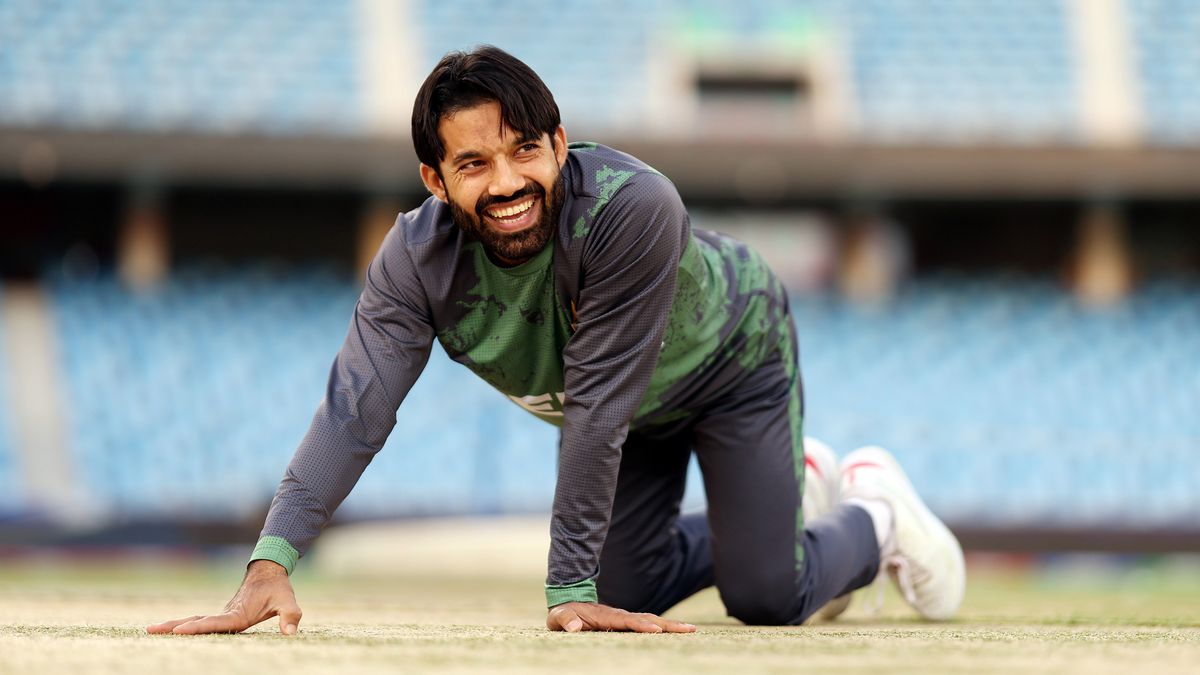Why 'cricket equals life' for technicolour commentator Bharat Sundaresan
There's a reason cricket commentator Bharat Sundaresan lives his life with gusto, donning technicolour outfits paired with painted fingernails and a radiant smile.He knows the high-profile, successful life he has now in Australia, the period he calls his "second innings," came close to being a duck.He could be dead.Bharat says he "owes a lot" to cricket. (Australian Story: Erin Semmler)He could have been hauled out in a body bag that day he overdosed on party drugs in his chaotic hometown of Mumbai, just as the then 21-year-old was about to embark on the journey to becoming an internationally renowned cricket journalist."People often ask me, 'Why do you smile all the time, why are you happy all the time?'," Bharat, now 39, tells Australian Story. "And I'm like, 'Dude, every morning I wake up is one more day than I deserve to live'.""The more colour the better": Bharat says living in Australia has helped him finally feel comfortable in his own skin. (Australian Story: Erin Semmler)Bharat has built a beautiful life in the Adelaide Hills with his wife, Isha, and two spoilt dogs, Olivia and Alfred. (Australian Story: Erin Semmler)'Just trying to be myself'It was his farewell party before he left Mumbai for Chennai, on the opposite coast of India. For three years, he'd been drifting, hanging out with his heavy-metal band mates as they kidded themselves they were practising for gigs. The truth was, Bharat was getting high most days, a crutch for the confusion in his life.Bharat felt like an outsider in India. He baulked at the rules, the divisions imposed by the caste-based society, the expected conformity.He'd grow his sleek, black hair long until his brother, with whom he had a volatile relationship, marched him to the barber to have it sheared off.He liked colourful clothes but his parents thought them flashy. "My parents would ask, 'Why do you want to be different?' And I would try to tell them, 'I'm not trying to be different. I'm just trying to be myself'."Chennai would be his escape. He'd been accepted into a journalism course, a job he knew little about but someone said he might be able to write about cricket — the one constant in Bharat's muddled life — and that was reason enough.Bharat "emerged a whole new person" after his near-death experience. (Australian Story: Erin Semmler)On the night of his farewell, he partied hard, popping a medley of pills like he'd done many times before.If you or anyone you know needs help: Lifeline on 13 11 14Kids Helpline on 1800 551 800MensLine Australia on 1300 789 978Beyond Blue on 1300 22 46 36Headspace on 1800 650 890National Alcohol and Other Drug Hotline on 1800 250 015This time, things went weird. His hands no longer obeyed him, as if taken over by some outside force. He felt like he was sinking. His heartbeat slowed and through the haze, Bharat realised he'd overdosed."And all I remember thinking is, 'That's it, I'm going to die a loser'," Bharat says.June 11, 2007, is etched in Bharat's mind, the day he swore off drugs after pulling through the near-death experience. "This new person … emerged out of it; completely different, completely at peace with himself," he says.He'd graduate, get married, get a job with The Indian Express as a cricket writer, break some big stories. But his second innings really kicked off after moving to Australia in late 2018, with the unflinching support of his wife, Isha Chatterjee."Australia feels so close to my heart," Bharat says. "It's allowed me to find something that I never could find in India, which is me. I found myself in this country. I owe a lot to Australia."Making a name for himself covering long practice sessions in the nets, Bharat soon earned the respect of players and colleagues alike. (Australian Story: Erin Semmler)Today, Bharat is one of the world's most recognisable and well-regarded cricket writers and commentators. Australian Test captain, Pat Cummins, says he's drawn to Bharat not only because of his deep love of cricket but his inquisitiveness about how the world works.Test batsman, Marnus Labuschagne, admires Bharat's intense study of cricket. "He always goes that level above trying to find out more about the game rather than reporting on results," Labuschagne says.Bharat was dubbed "the net whisperer" renowned for spending hours at the practice nets. (Supplied: Instagram/@bhara.sund)Broadcaster and former India head coach, Ravi Shastri, says he is an "absolute professional"."He's got the trust of the Australian cricket team as well. He's watching coaches. He's watching support staff. He's watching techniques, rhythm … and he writes beautifully."Bharat is renowned for spending hours at the practice nets, watching every step, every telltale move of the shoulder of the Australian cricketers. You can't miss him — he'll be the long-haired dude in the multicoloured outfit, sometimes matching, often not.And unless he's being challenged by an overzealous — or racist — security guard about his right to be on the grounds, he'll be smiling.Bharat Sundaresan's Australian Story episode airs Monday February 24 at 8:00pm (AEDT) on ABCTV, ABC iview and YouTube.Obsession creates a 'child stats guru'The first thing Bharat remembers is cricket. He was five and watching a televised test match between India and West Indies as a blistering fast bowler from Jamaica hurtled down the field."Two things happen in that moment," Bharat says. "I was hooked onto cricket … and I became a lifelong West Indies nut."Bharat remembers watching his first cricket match on TV as a five-year-old. (Supplied: Bharat Sundaresan)By the time he was seven, he was "The Stats Guru", the local kid who could be called upon to rattle off who scored what, when and where. If he was ill, he'd give his mother updates in cricket terminology. "Oh, we're seven wickets down," he'd say from his sick bed.Bharat (pictured with his brother) would tell his parents he wasn't trying to be "different" he was "just trying to be myself". (Supplied: Bharat Sundaresan)Cricket was one way the extroverted kid with a penchant for the dramatic could blend in. He loves India's passion for the game — but bristles at calling it a religion."Religion divides people in India," he says. "Cricket is what unites people."And it saved his life, he says, the lifeline that pulled him through after the overdose."Cricket is as much a part of me as I think anything in life … Because it did save my life. It kept me alive," Bharat says." Cricket equals life. Life equals cricket. "'I always knew he was special': Australia gives couple freedomHis other lifeline is his wife, Isha Chatterjee. The rise and rise of Bharat — from fledgling journalist to international cricket correspondent, broadcaster and author — cannot be separated from Chatterjee.They met on the first day of college. He was captivated. She was freaked out. "Bharat walks up to me," recalls Isha, "and he said: 'I think you're the most beautiful woman I have ever met. And I was just like, 'Oh, creep alert!'."Bharat says the relationship developed "organically". (Supplied: Bharat Sundaresan)But they became friends, a friendship that blossomed when both scored their first jobs in journalism in Mumbai (or Bombay as Bharat still refers to it as). Fate intervened when Isha's lodgings fell through and Bharat suggested she board at his home. Over time, they became a couple."It's not the most romantic of stories," Bharat says. "[Our relationship] happened so organically that we don't even have a starting date."They're different. Isha, who left journalism to become a special needs teacher and artist, is an introvert, more at home alone, working in her studio than in large groups. Bharat is loud, extroverted and makes friends easily."He'll go make friends with a door," Isha says, deadpan.But Isha also rebelled against the expectations of Indian society. "We always got the finger wag because we just always questioned," Isha says. "We always wanted to be who we want to be and wanted to break those norms, wanted to explore things."Isha says it's been a joy to watch her husband flourish in Australia. (Supplied: Bharat Sundaresan)It was Isha who led the way to Australia. They hatched a plan: she'd head over first to study a master's in special education and Bharat would follow when he could make it work.Isha landed in Adelaide in February 2017, walked out the airport and thought, "Oh my god, what have I done?". She was homesick, lonely and "wanted a hug". In two years, the couple saw each other for just two weeks, when Bharat visited.But come 2018, Bharat became the first Indian to be a foreign correspondent on Australian cricket after being offered a job with the leading Indian cricket website, Cricbuzz, which boasts more than 150 million mobile app downloads.Bharat says Isha made it all possible. "I always tell people it was the easiest move ever," he says. "I had a wife who still wanted me to come and live with her. She had a house she was renting. She bought a car."Together, they've made the Adelaide Hills and Australia home. Isha encourages her husband's colourful style, even sharing her clothes — the bright ones — with him."It’s not a case of falling in love 12 years ago, it’s about falling in love every day for the last 12 years," Bharat says of the relationship. (Australian Story: Erin Semmler)She's the one sending him design ideas for his painted fingernails. It's been a joy, says Isha, to watch her husband flourish."I always knew Bharat was very special," she says. "Moving to Australia has just given him the freedom to be himself. He's always been a great journalist but here, he's just found himself." It's just been wonderful to see how much he's been able to achieve here. "Bharat loves living in his community in the Adelaide hills. (Australian Story: Erin Semmler)How a tweet triggered torrent of abuseIt was Bharat's fifth summer working as a cricket journalist in Australia when a security guard challenged him as he entered the Melbourne Cricket Ground.It wasn't the first time. The accredited journalist had been stopped at other major ovals by guards, buffeted with a variety of snide and subtly racist remarks.This time, Bharat didn't shrug it off with a joke. He snapped back, then fired off a tweet, telling security guards that at some point, they had to stop questioning his credentials and whether they could trust him.The tweet went viral. Then, the Sydney Morning Herald asked him to write about his experiences of racism — the times he's been called a terrorist, the way people cross the road when they see him — and the debate took off.Bharat is glad he wrote it. He says the reaction was largely supportive — people stopped him in the street to thank him, or apologise, and the cricket fraternity, including high-profile former and current players, rose to hug him and shake his hand at the MCG.Loading YouTube contentThere was blowback, too, but Bharat argues he was not trying to bag Australia but to say, "Come on Australia, you can do better"."I realised that, especially now that I have a voice, what's the point of having a voice if I'm not going to use it," he says. "I poured my heart out into it."Because his heart is now with Australia. He'll always hold India close, but Australia is home now, where Bharat can be himself, where he belongs.Bharat has built a rapport with fellow journalists and cricketers alike including names like Pat Cummins and Marnus Labuschagne. (Australian Story: Erin Semmler)Bharat's approach to his work is to, "Do a job, put smiles on faces and go back home". (Australian Story: Erin Semmler)And in January, he started the process of making that official. Bharat has taken his Australian citizenship test, while Isha has taken the pledge to become an Australian citizen, something the couple called "one of the happiest days of our lives"."This country has done so much, so many wonders for us," Bharat says. "Does it have its issues? Which country doesn't have its issues?! I want to not just be Australian just for being an Australian. I think I can make a difference."Bharat, who loves spending time with his nieces, said "Australia is my forever home". (Australian Story: Erin Semmler)Watch Australian Story's Second Innings, 8:00pm (AEDT) on ABCTV, ABC iview and YouTube.









